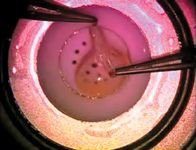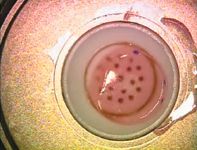Article
Femtosecond laser facilitates cutting of lamellar discs
Femtosecond laser (IntraLase, Advanced Medical Optics) technology is capable of performing nonmechanical dissection of the posterior lamellar disc for endothelial keratoplasty in a safe manner.

Key Points


To evaluate the feasibility of preparing the endothelial lamella using the laser, initially, the investigators evaluated the technique in three corneas provided to the investigators for research purposes and then progressed to human eyes. When the corneas were prepared, an artificial anterior chamber (Moria) was used with high anterior chamber pressure. Applanation was achieved by means of the femtosecond laser, and the goal, according to Dr. Tamburrelli, is minimal applanation to prevent folding of the cornea and a smoother surface in the horizontal cap.


This procedure can be performed independently or combined with cataract extraction. Following cataract extraction, Descemet's membrane is stripped under irrigation.
The endothelial cell count decreased markedly following the surgery, probably as the result of femtosecond laser energy, to about 1,000 cells/ mm2. Six months postoperatively, the cell count was about 1,200 cells/mm2, Dr. Tamburrelli said.
"We concluded that the [femtosecond] laser can make nonmechanical cuts for posterior LKP with relative ease and reliability. The posterior lamella can be prepared in eye banks and subsequently delivered to surgeons ready for transplantation. We found a high rate of endothelial cell loss that may have resulted from the femtosecond laser energy and the learning curve associated with the technique used to introduce the tissue into the eye. Both of these need further study," Dr. Tamburrelli concluded.
Newsletter
Don’t miss out—get Ophthalmology Times updates on the latest clinical advancements and expert interviews, straight to your inbox.




